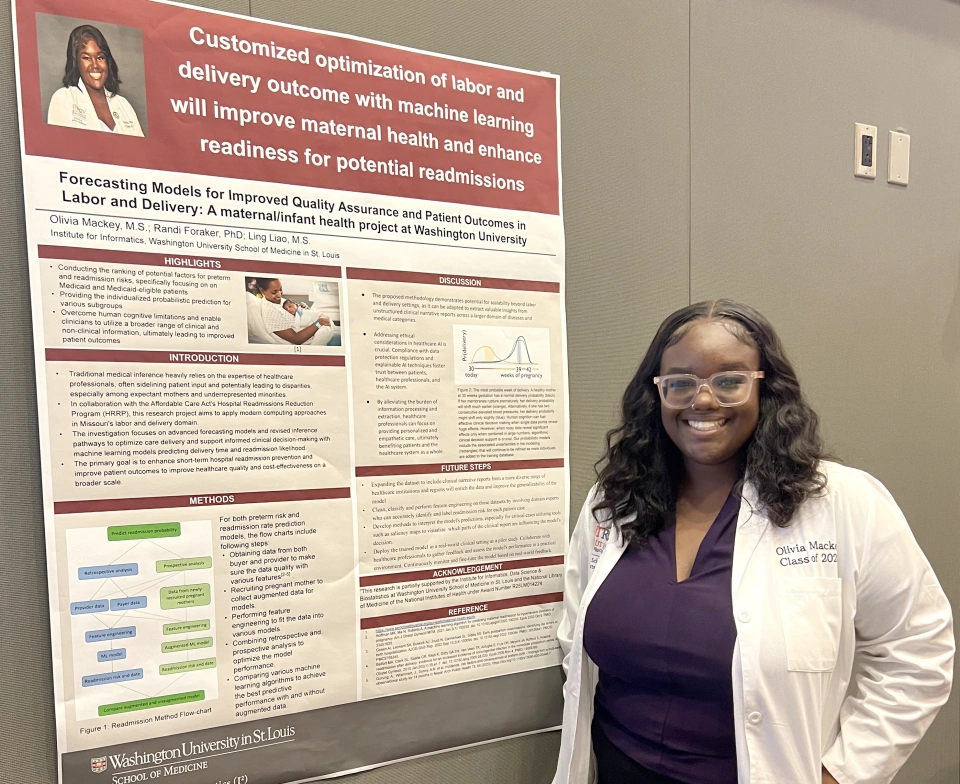By Karen Villarreal
RIO GRANDE VALLEY, TEXAS – Olivia Mackey had already been investigating the potential of artificial intelligence (AI) in healthcare, before she came to the Rio Grande Valley in 2022 from Missouri to join the inaugural class of the UTRGV School of Podiatric Medicine (UTRGV SOPM).
“Overall, AI does bring great benefit,” said Mackey, who contributed to two research projects started at the Washington University School of Medicine in St. Louis.
While one project she worked on used the latest version of Chat GPT, a popular AI tool, to summarize patient history and vitals to help the care providers identify at-risk patients, the other addressed maternal health, particularly the disparities among minorities and economically disadvantaged individuals.
AI’S POTENTIAL IN HEALTHCARE
Mackey collaborated with a partner, who had an informatics and coding-specific background, and learned to code – to “teach” Chat GPT Turbo 4.5, then the latest and most-improved version of the AI language processing tool, to accurately summarize patient history and vitals.
Their aim was to minimize the time care providers must spend reviewing patients’ charts, freeing them up to spend more time treating them.
They created a local and secure database that catalogued family history of disease, if the patient was a chronic smoker, had diabetes, and other clinical information. Then the AI program provided a summary that was accurate in 98 percent of their test cases.
“A computer is just faster than us,” she said. “The findings are pretty viable.”
The second project similarly built a patient data catalog. However, it was applied to identify pregnant Medicaid patients who may face critical complications.
She proposed that AI’s efficient review of a pregnant or recently pregnant woman’s chart can highlight complications the healthcare providers otherwise might miss among the charts’ myriad data points, and alert them about patients who are at risk of death related to the labor and delivery process.
“Applying the AI as a tool in healthcare could be the difference between life and death,” Mackey said.
ADDRESSING DISPARITIES
Mackey’s family moved from Nigeria to Houston, where she was born and raised. In the United States, she observed a lack of accessible care for people of color and later researched disparities in maternal death rates for Black women, especially those on Medicaid.
“These patients aren't able to have the best pre-natal care,” Mackey said. “Monthly checkups and birthing classes are luxuries they just cannot afford.”
According to the Center for Disease Control (CDC), black women face a higher proportion of preventable pregnancy-related deaths than white women to risks such as cardiomyopathy, hemorrhage, infection, thrombotic pulmonary embolism and hypertensive disorders of pregnancy.
Black communities face additional challenges in healthcare, including a shortage of doctors of color – less than 6% of physicians in the United States identify as Black or African American – microaggressions against those doctors, instances of medical professionals dismissing concerns and symptoms, and even outright abuses that diminish medical trust.
“Historically, African Americans don’t have a good relationship with the American health system. They don’t feel that it wants the best for them,” she said. “I, and my colleagues, are definitely very keen to get into the system to change that.”
CELEBRATING COMMUNITY
As Mackey continues her journey toward a Doctorate of Podiatric Medicine (DPM), she will be presenting her past work, including a presentation at the American Medical Informatics Association conference in March in Boston, Massachusetts.
However, her focus since coming to the UTRGV School of Podiatric Medicine has been meeting the unique needs of the Rio Grande Valley’s population. In her first year, she began research through the SOPM’s Regenerative Medicine Lab and is planning to continue seeking projects through her anticipated graduation in 2026.
With the high prevalence of Type 2 diabetes in the region, understanding and addressing the specific needs of diverse populations is critical, she said.
“As a future healthcare provider, I know my ultimate goal is to serve the patients and the community that I'm in,” said Mackey, vice president of the UTRGV SOPM’s chapter of the American College of Podiatric Medicine.
The group recently collaborated with the UTRGV School of Medicine’s Student National Medical Association on their second Black History Month celebration, “In Our Hues,” to be held Feb. 23, an event aimed at connecting students and healthcare professionals.
“The population of African Americans in the Valley is very small, so we get together, network, and just have a good time celebrating community,” Mackey said.
ABOUT UTRGV
The University of Texas Rio Grande Valley (UTRGV) was created by the Texas Legislature in 2013 as the first major public university of the 21st century in Texas. This transformative initiative provided the opportunity to expand educational opportunities in the Rio Grande Valley, including a new School of Medicine and a School of Podiatry, and made it possible for residents of the region to benefit from the Permanent University Fund – a public endowment contributing support to the University of Texas System and other institutions.
UTRGV has campuses and off-campus research and teaching sites throughout the Rio Grande Valley including Brownsville (formerly The University of Texas at Brownsville campus), Edinburg (formerly The University of Texas-Pan American campus), Harlingen, Weslaco, McAllen, Port Isabel, Rio Grande City and South Padre Island. UTRGV, a comprehensive academic institution, enrolled its first class in the fall of 2015; the School of Medicine welcomed its first class in the summer of 2016, and the School of Podiatric Medicine in the fall of 2022.

